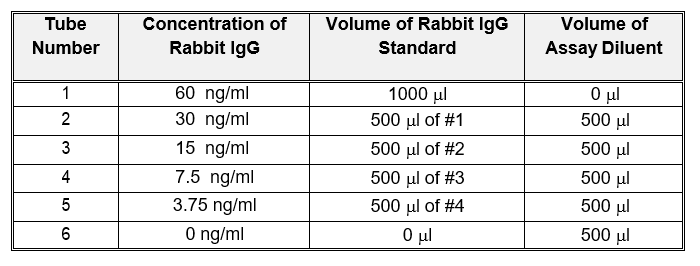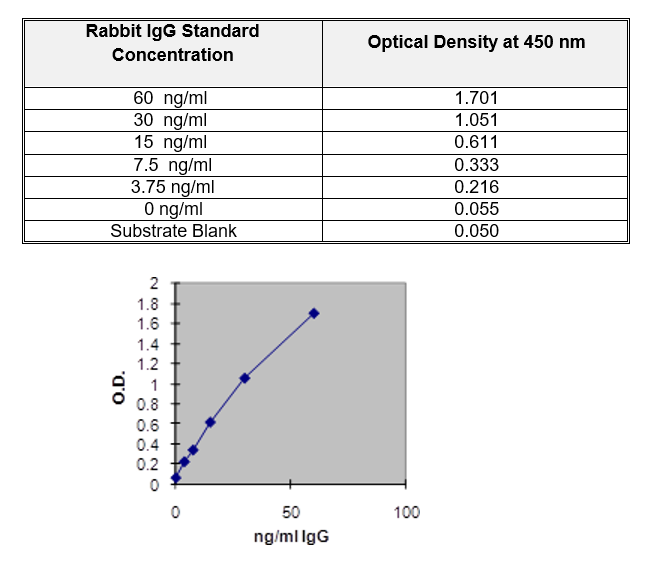Description
The IMMUNO-TEK Rabbit IgG ELISA Kit is a rapid, easy to use enzyme linked immunosorbent assay (ELISA) designed for the measurement of rabbit IgG in rabbit serum, plasma or other biological fluids. The assay contains ready-to-use reagents and takes less than two hours to perform. The microplate and detector antibody in the kit have been specifically balanced to react uniformly with all subclasses of rabbit IgG.
The IMMUNO-TEK Rabbit IgG ELISA Kit is for Research Purposes Only.
Zeptometrix | 0801202 | Rabbit IgG ELISA Datasheet
PRINCIPLE OF THE TEST
Microplate wells coated with polyclonal antibodies to rabbit IgG form the capture phase of the assay. These antibodies bind uniformly to all subclasses of rabbit IgG. Captured rabbit IgG then reacts with detector antibody, which is a polyclonal anti- rabbit IgG, conjugated with horseradish peroxidase. This reagent also reacts uniformly with all subclasses of rabbit IgG. Enzyme activity in the wells is then quantified using tetramethyl benzidine as a substrate.
REAGENTS
Materials Supplied:
- Microplate, (1x96 well): Strips coated with purified goat anti-rabbit IgG
- Detector Antibody (12 ml): Contains conjugated goat anti-rabbit IgG peroxidase
- Rabbit IgG Standard (7 ml): Contains rabbit IgG and Assay Diluent
- Assay Diluent (100 ml): Contains PBS, Triton X-100® and 2-chloroacetamide
- Plate Wash Buffer (125 ml): Contains PBS, Tween 20® and 2-chloroacetamide
- Substrate (12 ml): Contains Tetramethyl Benzidine (TMB)
- Stop Solution (12 ml): Proprietary formulation
- Microplate Sealers (1 pk): 10 sealers per pack
- Plastic Bag (1 bag): For storage of unused microplate strips
® Triton X-100 is a registered trademark of Union Carbide Chemicals and Plastics Co., Inc. Tween 20 is a registered trademark of Imperial Chemical Industries.
Materials required but not supplied:
- Disposable gloves
- Test tubes and racks for preparing specimen and IgG standard dilutions
- Validated adjustable micropipettes, single and multi-channel
- Distilled or deionized water
- Validated incubator capable of maintaining 37°C + 1°C
- Graduated cylinders and assorted beakers
- Validated microtiter plate reader
- Automatic microtiter plate washer or manual vacuum aspiration equipment
- Timer
STORAGE
Store all kit reagents at 2-8°C. Do not freeze.
PRECAUTIONS
FOR RESEARCH USE ONLY. Not For in vitro Diagnostic Use.
- Prior to performing the assay, carefully read all
- Use universal precautions when handling kit components and test *
- To avoid cross-contamination, use separate pipette tips for each
- When testing potentially infectious specimens, adhere to all applicable local, state and federal regulations regarding the disposal of biohazardous
- Stop Solution contains hydrochloric acid, which may cause severe In case of contact with eyes or skin, rinse immediately with water and seek medical assistance. Wear protective clothing and eyewear.
*MMWR, June 24, 1988, Vol. 37, No. 24, pp. 377-382, 387-388
PREPARATION OF REAGENTS
Plate Wash Buffer:
Dilute 10X Plate Wash Buffer 1:10 in distilled or deionized water prior to use. Mix thoroughly. Prepared 1X Plate Wash Buff er can be stored at 2-8°C for up to one week. Additional 10X Plate Wash Buffer (ZMC Catalog #: 0801060) may be ordered if needed.
Rabbit IgG Standard Curve
Label 6 test tubes as shown below. The rabbit IgG Standard is provided at 60 ng/ml. This should be diluted in Assay Diluen t as follows to prepare a standard curve.

SPECIMEN DILUTIONS:
Rabbit Serum or Plasma
Rabbit serum and plasma will normally contain 5-10 mg/ml of IgG antibody. Because of this, we recommend preparing a 1:200,000 dilution of rabbit serum in Assay Diluent for initial testing. After initial testing, it may be necessary to adjust the concentration of the antibody solution to be tested in order to obtain a concentration between 60 ng/ml and 3.75 ng/ml for accurate quantification.
TEST PROCEDURE
Allow all reagents to reach room temperature before use. Label test tubes to be used for the preparation of standards and specimens. If the entire 96 well plate will not be used, remove surplus strips from the plate frame and place into the resealable Plastic Bag with desiccant. Seal bag and store at 2-8°C.
Step 1: Label each strip on its end tab to ensure identity should the strips become detached from the plate frame during the assay.
Step 2: Designate one well on the plate and leave empty. This well will serve as a substrate blank.
Step 3: Pipette 200 ml of standards 1-6 into duplicate wells.
Step 4: Pipette 200 ml of each specimen into duplicate wells.
Step 5: Cover the microplate with a plate sealer and incubate the plate for 30 minutes at 37°C.
Step 6: Aspirate the contents of each well and wash the wells 4 times with 1X Plate Wash Buffer. To wash, fill the wells with 300 ml of 1X Plate Wash Buffer and aspirate. Perform 4 fill/aspirate cycles. After the final wash cycle, thoroughly blot the plate by carefully striking the plate on a pad of absorbent paper towels. Continue until no visible droplets of Plate Wash Buffer are observed.
Step 7: Pipette 100 ml of Detector Antibody into each standard and specimen well.
Do not add Detector Antibody to the substrate blank well.
Step 8: Cover the plate with a plate sealer and incubate for 30 minutes at 37°C.
Step 9: Wash the plate 4 times with Plate Wash Buffer as described in Step 6.
Step 10: Pipette 100 ml of Substrate into each well including the substrate blank well.
Step 11: Incubate the plate for 30 minutes at room temperature. A blue color will develop in wells containing rabbit IgG.
Step 12: Pipette 100 ml of Stop Solution into each well. A color change from blue to yellow will occur.
EXPECTED RESULTS
Below is an example of a typical standard curve. Variations will occur from laboratory to laboratory due to pipetting, incubator temperatures, plate readers, etc.

CALCULATION OF RESULTS
Test Validity:
For the test to be valid, the mean optical density of the 0 ng/ml standard and the substrate blank must be below 200.
Calculation:
- Using linear graph paper or a computer program, plot the optical densities of each standard on the Y-axis versus the corresponding concentration of the standards on the X-axis.
- The concentration of rabbit IgG in each diluted specimen may then be determined manually using a ruler to extrapolate, by linear regression using a computer program or pocket calculator with a linear regression function, or by point-to-point calculation again using a computer or
- Correct the diluted specimen values by the dilution factor used to obtain the final concentration of rabbit IgG in the original
PROCEDURAL FLOW CHART
PREPARE REAGENT DILUTIONS
=>
PIPETTE SPECIMENS AND STANDARDS
=>
INCUBATE 30 MINUTES AT 37º + 1ºC
=>
WASH PLATE
=>
PIPETTE DETECTOR ANTIBODY
=>
INCUBATE 30 MINUTES AT 37º + 1ºC
=>
WASH PLATE
=>
PIPETTE SUBSTRATE SOLUTION
=>
INCUBATE 30 MINUTES AT ROOM TEMPERATURE
=>
ADD STOP SOLUTION AND READ AT 450 NM
For Research Use Only NOT for in vitro Diagnostic Use
3 Reviews
-
imballaggio superbo
Sono rimasto colpito dalla confezione. Quando ho aperto il pacco, ho visto un telo di sicurezza attorno all'oggetto per proteggere la custodia interna da eventuali danni.
-
Envío rápido
Gracias Gentaur por su envío rápido y eficiente. La gente de Gentaur está bien entrenada y es responsable.
-
good support
The compay backing to its clients is generally excellent, gives fast reaction to clients and settle the questions of its buyres and clients.






